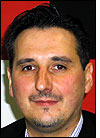Vorwerk Teppichwerke, a manufacturer of vacuum cleaners and carpets located in Hamlin, Germany, has launched the market debut of its “smart-floor” system, a flooring underlayment with embedded passive 13.56 MHz RFID tags.
Just like an ordinary underlayment—padding or other material placed over a subfloor to provide a smooth, stable surface for the finish material—Vorwerk’s RFID-enabled version serves as an insulator and noise reducer, and can be installed under a variety of flooring, including tile, hardwood, carpet and laminates. The smart-floor underlayment, however, also has embedded RFID tags, four per square meter, which can be programmed to navigate automated transport systems, such as robotic systems that deliver mail or clean floors.
After three years of research, Vorwerk has developed its underlayment to the point where it can be mass-produced, and the company hopes to begin selling it this year. InMach Intelligente Maschinen, headquartered in Ulm, which creates robots for such everyday tasks as cleaning or transporting goods or people, will design and manufacture robots with built-in RFID interrogators. Future Shape is writing the software for the system, according to Matthias Hanelt, Vorwerk Teppichwerke’s project manager for the smart floor. Vorwerk and InMach will sell the robots, underlayment and system software together as a smart-floor solution. As a result of the information stored on the underlayment’s embedded RFID tags, the robots will be able to orient themselves in a room and move toward precise targets on the floor.
The smart-floor underlayment is made of woven polyester, into which the specially designed RFID tags have been sewn. The tags consist of a tiny silicon ISO 15693-compliant microchip joined to an antenna coil and attached to an ultra-thin substrate made of polyethylene terephthalate (PET) plastic. The underlayment can be installed in all sizes and shapes and is cut with a standard carpet knife. If a tag is damaged when the underlayment is cut, the functionality of the other tags remains intact.
Each tag has its own ID number and holds 256 bits of read-write memory; in the future, the company plans to offer underlayment with tags holding as much as 10 kilobytes. A robot’s RFID interrogator can read a tag up to 10 centimeters away.
The robot’s built-in RFID interrogator can use the tag’s memory to store quality-control information about whether a target area or a room has been cleaned, and when it is to be cleaned again. By conducting an analysis of the tag data read by the robot, software can be programmed to send a robot back to places where obstacles have been removed. This allows it to achieve full coverage of the surface. System administrators can manage a fleet of robots from a central point, sending information to the robots via a control PC using Wi-Fi or Bluetooth.Current robotic cleaning systems frequently use infrared sensors or GPS for navigation, but those technologies are costly and GPS signals are often hard to receive within a building. In addition, such systems are often unable to achieve 100 percent coverage of a surface due to trashcans and other obstacles. In June 2005, Vorwerk announced the creation of its own Smart Carpet System, a robotic vacuum system equipped with an RFID interrogator that navigates floor spaces by reading a grid pattern of passive tags integrated into a carpet (see Sweeping RFID Under the Rug).
The family-owned company would not say how much the smart-floor system will sell for, though it did indicate buyers of a large fleet of robots might receive a quantity discount. The smart-floor underlayment alone (excluding robots and system software) may be sold for about 13 euros ($16) per square meter. According to Hanelt, other non-RFID underlayments can sell for 5 to 15 euros ($6 to $18).
Vorwerk’s RFID-enabled underlayment is a result of a “thinking carpet” research project the company began in 2003 with chip manufacturer Infineon Technologies. At present, the underlayment contains Infineon RFID microchips, but Vorwerk has the option to use chips from other vendors, as well.
Vorwerk expects to sell the system to building managers who oversee hospitals, nursing homes or other facilities where the locations of objects and/or people need to be tracked. Whole fleets of robots or robot-controlled carts or wheelchairs could move goods or people around, navigated by the RFID tags embedded in underlayment installed throughout the building. For example, the smart-floor could control the automated transport of empty beds to a cleaning station.
“We have had a lot of interest from facility management firms that want to improve the quality of their work. They want to know exactly which cleaning work has been done, and which has not,” said Hanelt.
The smart-floor system also offers interesting design possibilities for high-tech buildings. The number of tags per square meter can be changed on a custom basis to accommodate various designs or purposes.
“The additional use of the floor surface area in buildings has been, at best, confined to ventilation, heating and hiding cables and electrical outlets. With the smart-floor, that area is now going to be given a whole new technical functionality,” says Johannes Schulte, Vorwerk’s chairman of executive management.


